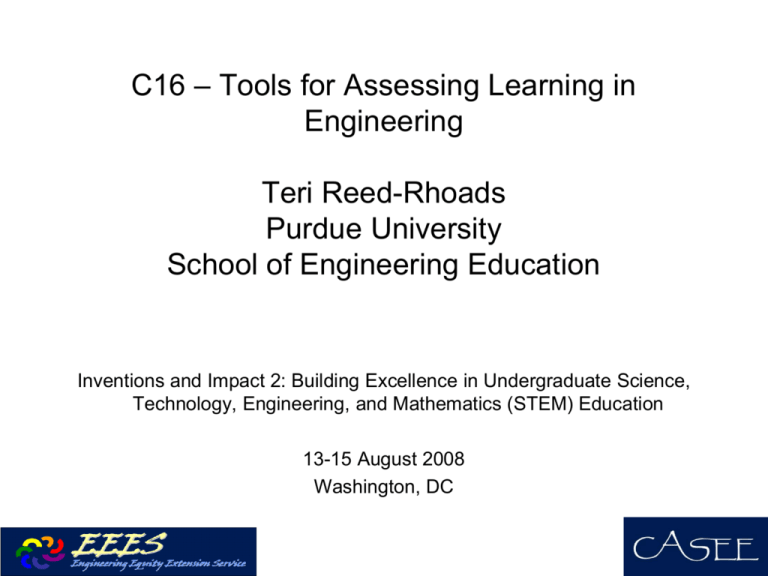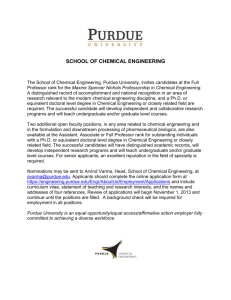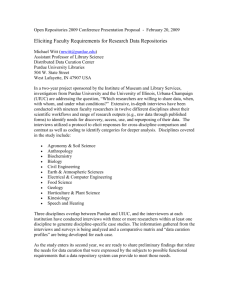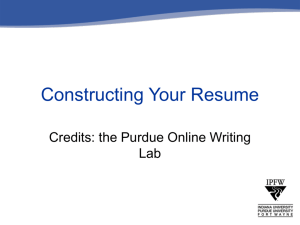View PPT - Course, Curriculum, and Laboratory Improvement
advertisement

C16 – Tools for Assessing Learning in Engineering Teri Reed-Rhoads Purdue University School of Engineering Education Inventions and Impact 2: Building Excellence in Undergraduate Science, Technology, Engineering, and Mathematics (STEM) Education 13-15 August 2008 Washington, DC Engineering Education Grant Writing Workshop ASEE Section Meeting April 3, 2008 Teri Reed-Rhoads Purdue University trhoads@purdue.edu Assessment • Formative – checking along the way • Summative – final analysis of achieving research goals • Consider an outside evaluator – unbiased, measurable feedback • Consider an external advisory board • Give details, actual tools, timelines, etc. Assessment • • • • Course Curriculum Program Project Types of Assessment – Cognitive Domain • Content knowledge (Concepts) • Process knowledge, e.g., teamwork (Skills, Abilities) – Student interest, perceptions, and attitudes (Affective) – Rate change (Achievement) PD’s Response – Goals on Cognitive Changes • Goals on cognitive changes – Increase understanding of concepts • • • Ability to solve statics problems Ability to construct free-body diagrams Ability to describe verbally the effect of external forces on a solid object – Increase processing skills • • • Ability to solve out-of-context problems Ability to visualize 3-D problems Ability to communicate technical problems Connie Della-Piana, Russ Pimmel, Bev Watford “Project Evaluation”, Workshop for Faculty from Minority Serving Institutions, Feb. 8 –10, 2006. Concept Inventories https://engineering.purdue.edu/SCI/worksho p/tools.html • Engineering Related – 20 instruments • Science and Mathematics Related – 8 instruments • Physics and Astronomy Specific – 12 instruments 4. 5. 6. 7. 8. 9. Engineering Related CI 10. 1. Chemistry 11. 2. Circuits 12. 3. Computer Engineering 13. 4. Computer Science 14. 5. CS (Intro) 15. 6. Discrete Math (CS) 16. 7. Dynamics 17. 8. Electromagnetics 18. 9. Electronics 19. 10. Fluid Mechanics 20. 11. Heat Transfer 12. Materials 13. Nanotechnology 14. Signals and Systems 15. Statics Computer Science CS (Intro) Discrete Math (CS) Dynamics Electromagnetics Electronics Fluid Mechanics Heat Transfer Materials Nanotechnology Signals and Systems Statics Statistics Strength of Materials Thermal and Transport Sciences Thermodynamics Waves Engineering Related CI Science and Mathematics CI Science and Mathematics CI 1. Biology 2. Calculus - Nelson 3. Calculus - Epstein 4. Chemical Equilibrium 5. Geosciences 6. Natural Selection 7. Organic Chemistry 8. Physics* Physics Physics and Astronomy CI* and Astronomy CI* 1. 2. 3. 4. 5. 6. 7. Force Concept Inventory Mechanics Baseline Test Astronomy Diagnostic Test Brief Electricity and Magnetism Assessment Conceptual Survey in Electricity and Magnetism Diagnostic Exam Electricity and Magnetism Determining and Interpreting Resistive Electric Circuits Concept Test 8. Energy and Motion Conceptual Survey 9. Force and Motion Conceptual Evaluation 10. Lunar Phases Concept Inventory 11. Test of Understanding Graphs in Kinematics 12. Light and Color *Rebecca S. Lindell, Elizabeth Peak and Thomas M. Foster, “Are They All Created Equal? A Comparison of Different Concept Inventory Development Methodologies”, 2006 Physics Education Research Conference Proceedings, American Institute of Physics. Goals on Process Knowledge • Teamwork – Team Effectiveness (Imbrie) – Team Developer (McGourty) • Communications – 3-D Visualization – Etc. • Leadership PD’s Response – Goals on Affective Changes • Goals on affective changes – Improve students’ attitude about • Profession • Curriculum • Department – Improve students’ confidence – Improve students’ intellectual development Connie Della-Piana, Russ Pimmel, Bev Watford “Project Evaluation”, Workshop for Faculty from Minority Serving Institutions, Feb. 8 –10, 2006. Affective Measures • Pittsburgh Freshman Engineering Survey (Besterfield-Sacre) • Attitudes Toward Statistics (Wise) • Computer Science Attitude Survey (Moskal) • Structured Interviews Table 4: Sample Factors from Pilot Interviews Factor Category sample factors identified in pilot study interviews with ten students majoring in Industrial Engineering at OU I. Student's a. strong desire for b. strong interest in c. exposure to d. exposure to Background career with people math and science science and computers at home orientation engineering via and in school family II. Attributes of the a. scholarship b. student c. OU is close to d. like OU Institution opportunities organizations and home networking III. Attributes of a. switch from b. people oriented c. useful to public d. challenges, the Field chemical or and human factors opportunities, and petroleum engr flexibility IV. Pedagogy/ a. interaction with b. interactive and c. feedback from d. student work Curriculum faculty group work faculty has relation to real life V. Department a. interaction b. women role c. faculty invite d. faculty are Culture between faculty models participation in approachable projects VI. Student's a. graduate school b. balance c. seeks work for d. developing Future between family company w other interests, and work community e.g., music involvement and flexibility Consider a Graphic I I b a c VI b c II b d c a IV II d b V a c c VI b c III III V a d IV (A) factors related to people interests (B) factors related to STEM interests Figure 1: Complex Interrelationships Among Factors, Based on Pilot Interviews PD’s Response – Goals on Achievement Rate Changes • Goals on achievement rate changes – Improve • Recruitment rates • Retention or persistence rates • Graduation rates Connie Della-Piana, Russ Pimmel, Bev Watford “Project Evaluation”, Workshop for Faculty from Minority Serving Institutions, Feb. 8 –10, 2006. Know the Motivation or Background Table 1: Proportion of Women in Selected STEM Fields Participating Departments IE Chem E(a) Mathematics Physics CS(a) AME(a) OU students(b) 47/84 126/325(c) 24/75 16/75 46/312 45/338 55% 39% 32% 21% 15% 13% students nationwide(d) 25% 33% 46% 20% 24% 12% OU faculty(e) 4/10 1/15 3/29 4/28 2/12 1/15 40% 6% 10% 14% 17% 6% faculty nationwide 10% (f) 8% (f) 19% [13] 8% (g) 11% (h) 6% (f) URMs 30% of population, few in labor force Women 50% of population, 10% in labor force # of BS Engineering Degrees 1966 Under Represented Minorities Women 146 (0.4%) % of Freshman Engineering Class 1977 2002 1975 2001 1,915 (4.8%) 7,971 (11.6%) 17.4 15.8 1,961 (4.9%) 14,102 (20.5%) 19.9 18.3 Chubin and Babco (2003), Walking the Talk in Retention to Graduation Engineering Disciplines Retention Rates Engineering Discipline Proportion Women Proportion URM Total URM NonURM Chemical 32.4 11.5 35.0 48.1 Civil 20.1 13.2 37.9 44.2 8.8 47.6 58.7 Computer Electrical 11.8 14.3 36.3 47.2 Industrial 29.4 17.7 44.2 51.3 Mechanical 12.0 11.0 38.0 48.7 Total 19.0 11.7 38.9 49.5 Chubin and Babco (2003), Walking the Talk in Retention to Graduation National Science Foundation. Women, Minorities, and Person with Disabilities in Science and Engineering: 2000. Arlington, VA, 2000 (NSF 00-327) Table 2-3 Evaluation Table Goal Increased retention of women students in engineering Objective Develop courses with interdisciplinary focus to connect eng with societal concern Evaluation Technique Retention data after each semester & for cohorts after 4 and 5 years Anticipated Outcome Increased percent of women remaining in any engineering major Authentic Teaching Alliance Assessment Cycle 11. Data entered, compiled, summarized and reported to stakeholders in Summer Workshops 1. Attitude & Experience surveys, Pre-year administration to K-12 students Aug Sept 10. Attitude & Experience surveys, Post-year administration to K-12 students 9. Teacher Exit Interviews Fellow Exit Interviews Faculty Adviser Interviews Summer Fall Semester June May 3. External Evaluation Oversight Committee Dec 8. Communication Skills Survey given to Fellows 7. Activity Analysis by teachers and fellows reflecting following each lesson 2. Activity Attitude Assessments by K-12 students following each activity in the semester Spring Semester Jan 6. Activity Attitude Assessments by K-12 students following each activity in the semester 4. Activity Analysis by teachers and fellows reflecting following each lesson 5. Portfolio collection fellows reflection on ATA experiences Group Questions 1. What are the known instruments/methods in each of the three areas? (Cognitive, Affective, and Rate Change) 2. Where have these been used successfully/unsuccessfully? 3. Where are the gaps in each area? Process • • • • One note taker One reporter Everyone discusses We will report out with 15 minutes left There is no failure. Only feedback. -Anonymous Happy grant writing! trhoads@purdue.edu https://engineering.purdue.edu/SCI/Workshop Affective • National academy of engineering website with book of surveys Rate Change • Longitudinal measurements, courses, rate changes of minorities, retention, enrollment, GPA for performance measures • Use Associate Dean’s offices as resources for stats, changes, etc. Wish • Critical Thinking – one that is free • Definition of engineering changes for students as they go through the curriculum • Digital Systems within computer engineering • Teaming attitude by individual • Measuring how well the student can deal with an out of box situation. • Clearinghouse that explains what already exists, how long is it, how it was used in the past, cliff notes version Wish • ABET could sponsor (or someone) or post tools that are being used • More CI https://engineering.purdue.edu/SCI/workshop /tools.html • Tools for writing and communication • Life-long learning tools (continuous learning) • Procedural knowledge on engineering design • FREE Critical Thinking Wish • Meta-cognition • Societal context of knowledge, global competencies, service learning, research skills, discourse and collaborative dialogue, oral communication, problem solving, leadership (some instruments from Business schools), ability to integrate knowledge, longitudinal data, qualitative data analysis • Evaluation of case studies Cognitive • Math placement test • English Placement test • Concept Inventories https://engineering.purdue.edu/SCI/workshop/tools.ht ml • FE, GRE – standardized tests • Critical thinking – Criticalthinking.org – has tools, and rubric developed by Gary Brown at Washington State, Watson Glazier (also not free), U of South Carolina EFFECTS (web-based) – http://www.ce.sc.edu/effects • • • • California Critical Thinking Collegiate Learning Assessment CAAP – from ACT SALG – Student Assessment of Learning Gains • IDEA – teaching assessments • MSLQ – Motivated Strategies for Learning Questionnaire • NSF User Friendly Guide to Assessment • • • • • Rogers and Sando, Rose-Hulman Learning Styles Instruments (Kolb, Felder) Career Instruments (Holland) FMRI, Caps measuring brain activity Experience sampling method – student wears a bracelet and when it goes off the student writes down what they are doing (engagement measures) • Calibrated Peer review • Teamwork effectiveness (Imbrie, Smith, Layton) • National Center for Case Studies (Buffalo)




